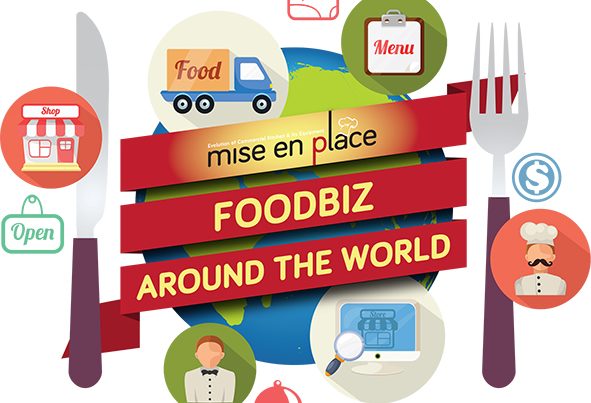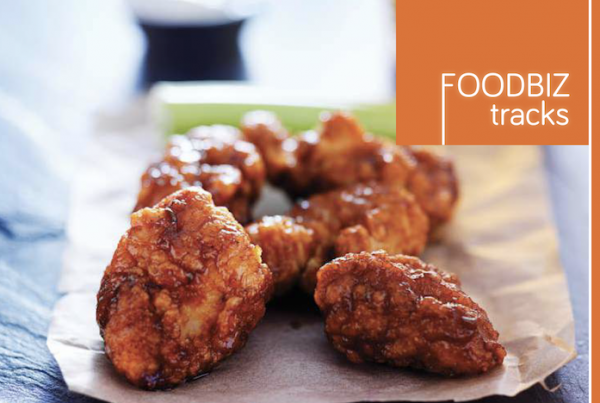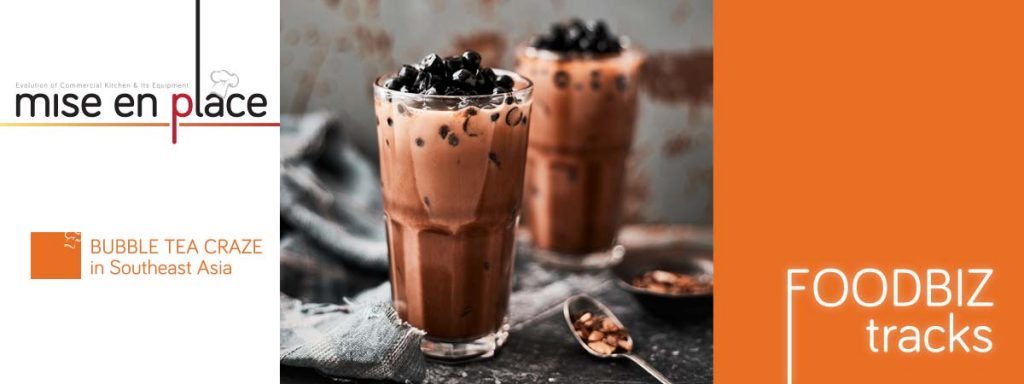 First introduced in Taiwan in the 1980s, bubble tea slowly took the online foodies by storm and eventually made the drink a global phenomenon. Social media influencers and consumers regularly post their colorful beverage on social media, grabbing more attention and fueling the demand for the product.
First introduced in Taiwan in the 1980s, bubble tea slowly took the online foodies by storm and eventually made the drink a global phenomenon. Social media influencers and consumers regularly post their colorful beverage on social media, grabbing more attention and fueling the demand for the product.
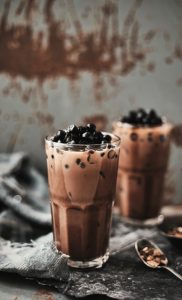
Bubble tea, also called pearl milk tea, bubble milk tea, or boba contains tea combined with milk, varying levels of sugar, and chewy tapioca balls or pearls for toppings. Bubble tea now comes in a wide variety of flavors and with various toppings such as grass jelly, fruit jelly, and aloe vera jelly, among others.
In a Grab article published on May 9, 2019, the ride-hailing app noted bubble tea’s popularity on GrabFood, its food delivery service. The article shared insights on the bubble tea craze in Southeast Asia. According to the report, bubble tea orders had increased at a whopping 3,000 percent in 2018.
Grab also reported that on average, Southeast Asians drink an average of four cups of pearl milk tea per person per month. Thai consumers take the lead for ordering about six cups per person per month. Filipino consumers take the second spot for consuming an average of five cups while Malaysia, Singapore, Vietnam and Indonesia drink an average of three cups.
Here’s a closer look at how bubble tea introduced the novel way of drinking tea in Southeast Asia and how it became so popular in the region, either as a lunch meal companion or a mid-day energiser.
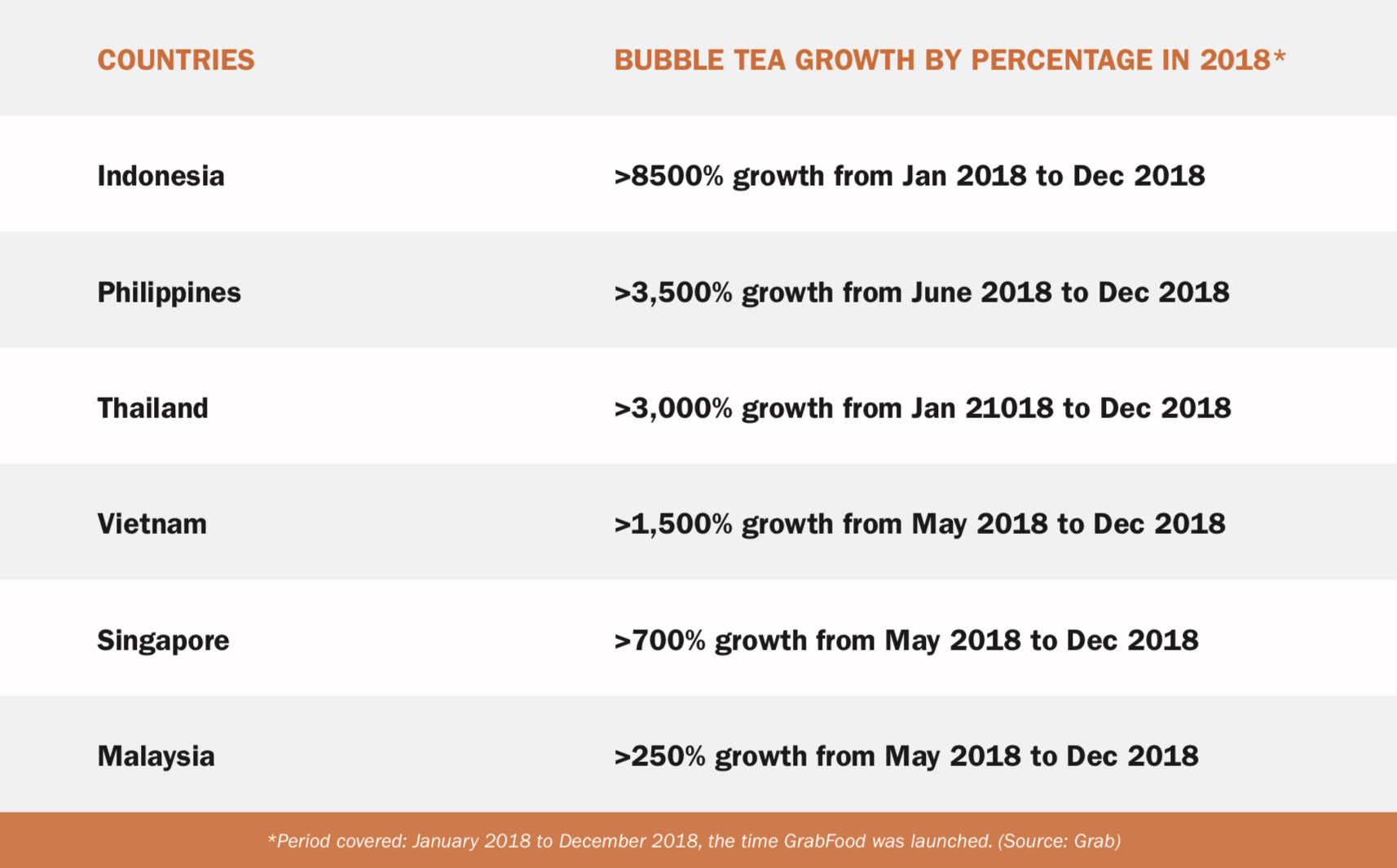
THAILAND
With Thais ordering an average of six cups of bubble tea per month from the GrabFood app, and this number being limited to Grab’s data – bubble tea business is undoubtedly bubbling in Thailand. Bubble milk tea shops and kiosks are a popular sight at shopping complexes, business areas, universities, train stations, and universities. But when and how did bubble tea invade the shores of Thailand?
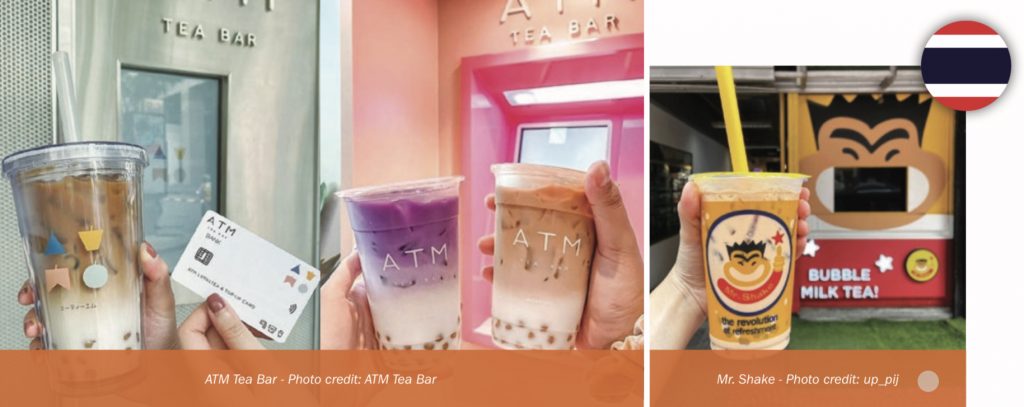
The product arrived in Thailand over a decade ago but then it fizzled out. In 2018, probably because of social media influencers, with online foodies and bloggers “documenting” their bubble tea experiences, the product made a strong comeback and became trendy again. Suddenly, there was a boom for bubble tea franchises. Bubble tea shops keep on mushrooming with new menus and innovative offerings, from unique toppings to healthy alternatives.
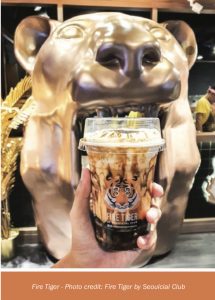
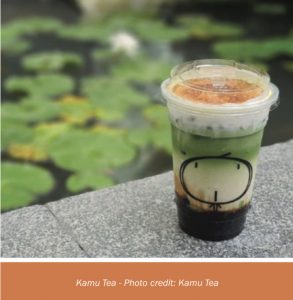
Mr. Shake Beyond is among the local’s favorite, probably because of its soft boba pearls. ATM tea bar, which allows customers to place their orders via an ATM-like vending machine, is a popular concept. Another brand that offers a unique concept is Fire Tiger by Seoulcial Club, where you will get your bubble tea from the shop’s icon tiger’s mouth. Kamu Tea prides itself of being environment-friendly, allowing customers to bring their own cup. They also claim to use real milk ingredients instead of creamer.
Other popular outlets in Thailand are Dakasi, Koi Thé, Ochaya, Osaka Milk Tea, The Alley, and Mr. Cup T Tea and Coffee.
Who embraces this modern tea-drinking culture in Thailand? Although the biggest group of bubble tea drinkers are teenagers and people under 25 years old according to Tamntea.com, it’s a “whole nation of tea- drinkers indulging in a new trend that has taken them by storm.”
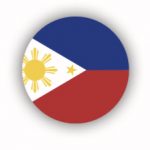 PHILIPPINES
PHILIPPINES
Before the pearl milk tea craze in the Philippines, Nestea Iced Tea (powdered iced tea), Lipton Iced Tea, and C2 bottled iced tea were the popular cold tea drinks.
Milk tea arrived in the country in December 2008 when Serenitea founders set up its first shop in San Juan City, Metro Manila. Just a few months after the homegrown brand was launched, the Filipino’s love for milk tea started to build up. This trend was highly influenced by food bloggers and social media. Serenitea’s popularity then caught the attention of some entrepreneurs and started setting up milk tea shops near schools and universities. Targeting the students proved to be a genius marketing strategy. The young population embraced the product and the milk tea shops started to compete head on with coffee shops.
In 2010, the milk tea popularity reached a new height when the University Athletic Association of the Philippines (UAAP) basketball star Chris Tiu brought Taiwan’s Happy Lemon brand to the Philippines. Customers were queueing up for milk tea.
The following year, other Taiwanese brands entered the Philippine shores. Gong Cha and Chatime became household names.
2013 marked another milestone – and a setback – in the country’s milk tea arena. More brands came in, and in addition to old-time favorites, Dakasi and Tokyo Bubble Tea also became crowd favorites. In the same year though, the milk tea craze suffered a blow when contamination was reported in Iloilo in the Western Visayas region. The milk tea was reportedly contaminated with E. Coli and salmonella, causing 50 customers to fall ill, and one of them died.
When a study came out investigating the risk of consuming pearl milk tea, highlighting the hidden ingredients of this presumably “healthy drinks”, people started talking about sugar, sweeteners and artificial flavourings. Brands were quick in offering more nutritious versions – tea brewed from real tea leaves, low sugar content, low-fat or skimmed milk instead of creamers, and healthier toppings like fruits and chia seeds.
More popular Taiwanese milk tea brands came to the Philippines in 2017, including Macao Imperial and Yi Fang Taiwan Fruit Tea. Thai brand Cha Tuk Chak arrived as well. These new names signaled the huge comeback of the pearl milk tea.
From then on, the brands introduced more product innovations and unique flavors, not just to please the palate but also to decorate the bubble tea fanatics’ Instagram page. Many took their love for Macao Imperial’s Kitten Milk Tea and Matcha Cheesecake to social media. Tiger Sugar, a Taiwanese milk tea franchise, is also making waves on Instagram when they introduced the brown sugar syrup stripes on the cup.
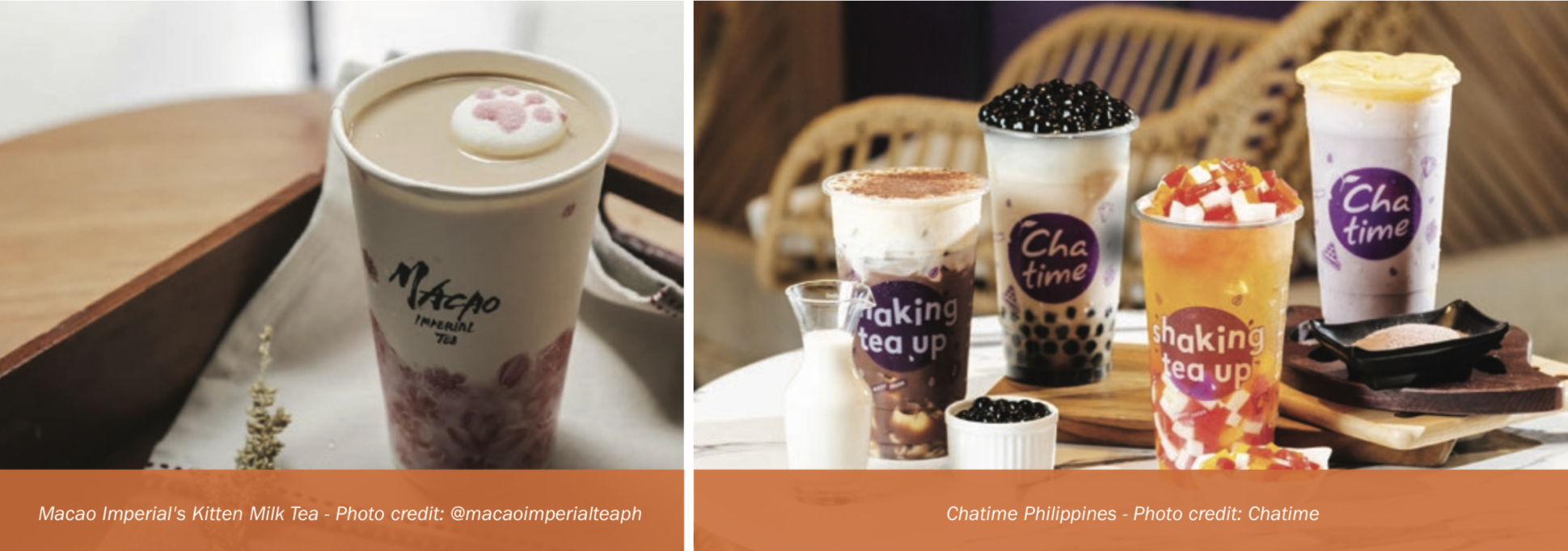
With a high number of milk tea shops all over the country, the milk tea craze in the Philippines had reached an all-time high. From a few flavours, the options have grown and many shops now offer an extensive menu.
And now that consumers can easily have their favorite milk tea brand and flavored delivered to their doorsteps, the trend had reached a new level of fad.
MALAYSIA
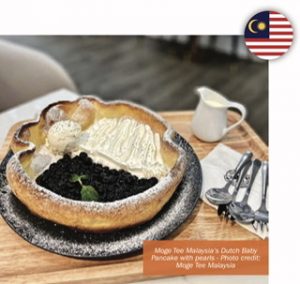 Bubble tea franchises and shops sprout like mushrooms in Malaysia, particularly in Kuala Lumpur. Many brands won the hearts of many customers, as evidenced by long queues of people waiting for one hour or more for that cup of bubble tea.
Bubble tea franchises and shops sprout like mushrooms in Malaysia, particularly in Kuala Lumpur. Many brands won the hearts of many customers, as evidenced by long queues of people waiting for one hour or more for that cup of bubble tea.
According to bubbleteamalaysia.com, there are over 100 bubble tea brands in Malaysia as of December 4, 2019. The list continues to grow, a positive sign that the trend will not experience a flatline soon.
But when and how did pearl milk tea arrive in Malaysia? It is uncertain, but many attributes the start of bubble milk tea to Bryan Loo of Loob Holdings. He was the one who brought Taiwan’s popular brand Chatime to Malaysia in 2010. A year later, Go Cha franchise came in. The arrival of international chains started the first wave of bubble tea craze in the country.
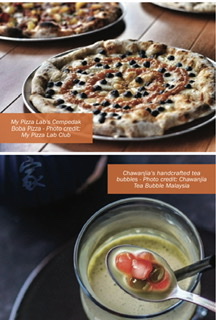 The “SS15 Bubble Tea Street” in Subang Jaya, Selangor is a testament to the country’s obsession with bubble tea. Among the popular milk tea shops in SS15 are Gong Cha, Chawanjia, Shifen Station, Xing Fu Tang, Tealive, Daboba, Mui Tea, TeaAmo Subang Jaya, OneZo Malaysia, and Moge Tee.
The “SS15 Bubble Tea Street” in Subang Jaya, Selangor is a testament to the country’s obsession with bubble tea. Among the popular milk tea shops in SS15 are Gong Cha, Chawanjia, Shifen Station, Xing Fu Tang, Tealive, Daboba, Mui Tea, TeaAmo Subang Jaya, OneZo Malaysia, and Moge Tee.
Gong Cha Signature Tea uses freshly brewed black, green, Oolong or melon tea, with a creamy layer of fresh milk foam on top. Chawanjia is popular among those who prefer handcrafted pearls made from fruit and vegetable extracts blended with tapioca powder. Shifen Station’s bestsellers are Marblearl Milk Tea and its latest craze Soy Milk Tea with Mitarashi Mochi. Xing Fu Tang is regarded as the first Taiwanese stir-fried brown sugar bubble milk tea in Malaysia.
Daboba’s honey golden pearl made the brand stand out in the ocean of pearl milk tea shops. Their roasted brown sugar pearl fresh milk with cheese on top is a crowd favorite. Moge Tee offers not only tea-inspired drinks. What sets them apart from the other brands is giving a fresh spin to their desserts. The shop also serves fluffy souffle with boba pearls on top and Dutch Baby Pancake with Pearls.
Interestingly, Malaysian’s love for bubble tea has evolved from being merely sugar-laced concoctions to colorful desserts. Bubble tea is now also present in cakes, waffles, toasts, and even pizzas too. These places in Kuala Lumpur gave bubble tea a whole new life: My Pizza Lab (serves Boba Pizza, available in OG Boba Milk and Cempedak flavors), Thurs2.0 (offers French Earl Grey Bubble Milk Tea Cake), TeaCottage (serves Bubble Milk Tea Waffle), TinyBaker in Pink (sells Bubble Earl Grey Chiffon Cake), Chubbeecloud Damansara Utama (offers Brown Sugar Boba Toast). The most interesting item would be the Crab Generation Restaurant’s bubble tea crab.
All these food and beverage innovations have taken Instagram by storm.
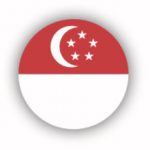 SINGAPORE
SINGAPORE
Singapore’s love affair with bubble tea started in 1992, much earlier than most of its neighboring countries. Bubble Tea Garden in Marina Square was bubble tea’s birthplace in the country. Popular flavors then were Pearl Red Bubble Tea, Yam Shake, Whisky Red Tea, Honey Egg Yolk, and Honey Peppermint. Back then, bubble tea was served in fancifully shaped cocktail glasses, unlike today when most shops serve their milk tea in disposable plastic cups.
Although the product was well received by students, bubble tea only became remarkably popular in 2001. Lengthy queues in front of bubble tea shops became a common sight and customers were all patiently waiting for their orders. Cool Station, Quickly, and Milk Girl Ice Cup brands became household names.
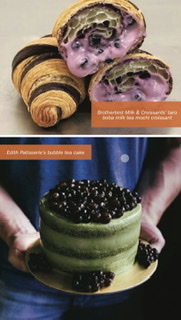 However, intense competition turned the bubble tea industry upside down in 2003. DIY kits and classes to make bubble tea also became popular, and it badly hit the market demand for bubble tea. As a result, many shops across Singapore folded.
However, intense competition turned the bubble tea industry upside down in 2003. DIY kits and classes to make bubble tea also became popular, and it badly hit the market demand for bubble tea. As a result, many shops across Singapore folded.
The beverage re-appeared in the scene in 2007. Foreign brands came in and captured the hearts of people across generations. By 2011, there were already over 10 franchises and about 500 shops selling pearl milk tea, including newer brands such as Gong Cha and Koi.
Fast forward to today, the Singapore food and beverage arena is filled with dozens of players from Taiwan, Korea, China and Thailand. The names include The Alley, The Koi, Xi Fung Tang, Supertea, Winnie’s, Hollin, PlayMade, Jenjudan, Sharetea, and Tai Gai Tea. Homegrown brands include Each-A-Cup, LiHo, Woobbee, I-tea, and Hi Tea.
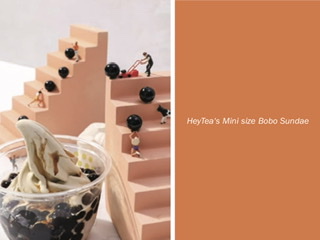 Over the years, the toppings have also undergone various transformations. From the classic black pearls, many shops now offer chrysanthemum pearls, grass jelly, aloe vera, and konjac jelly. Other outlets have become more innovative and offer freshly made matcha, coffee, chocolate, and peanut butter flavored pearls. LiHo’s Taro Soy Latte uses 100% pure taro for its taro paste and taro ball.
Over the years, the toppings have also undergone various transformations. From the classic black pearls, many shops now offer chrysanthemum pearls, grass jelly, aloe vera, and konjac jelly. Other outlets have become more innovative and offer freshly made matcha, coffee, chocolate, and peanut butter flavored pearls. LiHo’s Taro Soy Latte uses 100% pure taro for its taro paste and taro ball.
Just like in Malaysia, the bubble tea craze has also spread from being a beverage treat into a food item. TP Tea, Hey Tea, and Shuang Yeh offer bubble tea ice cream. Edith Patisserie offers bubble tea cakes and tarts while Brotherbird Milk & Croissants offers taro boba milk tea croissant and brown sugar boba milk mochi croissant on weekends. At Spice World Hotpot at Clarke Quay, popping bubble is served hot at their bubble tea hot pot.
INDONESIA
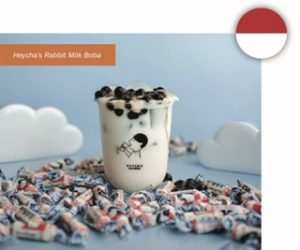 The bubble tea invasion in Indonesia started in 2000 with the opening of Quickly, the first bubble tea shop in the country. Indonesians lined up for their milk teas, the most popular product being Taro Milk Tea which remains a crowd favorite until today. In 2011, Chatime opened its first outlet in Jakarta. Currently, the brand has over 200 shops across the country. Other international players have arrived such as Koi Thé, Xing Fu Tang, Tiger Sugar, Sharetea, OneZo, and Kamu.
The bubble tea invasion in Indonesia started in 2000 with the opening of Quickly, the first bubble tea shop in the country. Indonesians lined up for their milk teas, the most popular product being Taro Milk Tea which remains a crowd favorite until today. In 2011, Chatime opened its first outlet in Jakarta. Currently, the brand has over 200 shops across the country. Other international players have arrived such as Koi Thé, Xing Fu Tang, Tiger Sugar, Sharetea, OneZo, and Kamu.
Some homegrown brands also stirred the local market. These include Heycha and its sister company Heychago, Goola, Kopi Soe, IN Tea, Yu Cha, Gulu Gulu and the unicorn-themed Kokumi.
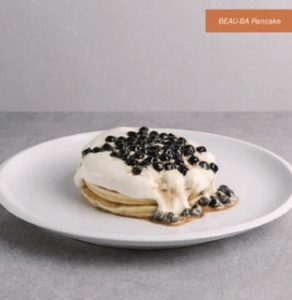 Recent innovations fan more excitement, encouraging more customers to rush to the nearest outlet, even though it would mean waiting for hours to purchase bubble tea. Interesting flavors include Gooma’s version of Pei Pa Koa milk tea and Heycha’s Matcha Rabbit Milk Boba.
Recent innovations fan more excitement, encouraging more customers to rush to the nearest outlet, even though it would mean waiting for hours to purchase bubble tea. Interesting flavors include Gooma’s version of Pei Pa Koa milk tea and Heycha’s Matcha Rabbit Milk Boba.
Food and cocktails in Indonesia also made the bubble tea hype in the country more interesting. Baiza Sushi serves Salmon Salad Boba, Spicy Salmon Roasted Boba, and Mango Sticky Sushi. Zodiac, a music bar and mini nightclub in Jakarta, collaborated with Quickly and came up with customised boba-cocktails. The most popular flavor is the Sugahill Taro, a mix of Quickly’s Taro Milk Tea with a tinge of bourbon. The cocktail is topped with tapioca pearls.
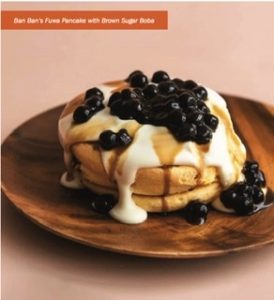 Some pastry shops infused their goods with tapioca balls. Ban Ban’s signature Boba Pan is a great hit. It comprises buttery warm brioche toast, cream cheese, and chewy boba pearls. The shop also serves Kuranchi Boba Pan, a toast served with pan- fried cheese and soft, signature Ban Ban pearls. Artisanal bakery, Beau, offers BEAU-BA Pancake and the BEAU-BA French Toast. Manatea Softserve offers soft ice cream with boba pearls topping.
Some pastry shops infused their goods with tapioca balls. Ban Ban’s signature Boba Pan is a great hit. It comprises buttery warm brioche toast, cream cheese, and chewy boba pearls. The shop also serves Kuranchi Boba Pan, a toast served with pan- fried cheese and soft, signature Ban Ban pearls. Artisanal bakery, Beau, offers BEAU-BA Pancake and the BEAU-BA French Toast. Manatea Softserve offers soft ice cream with boba pearls topping.
The surge of bubble tea popularity in Indonesia is at a high level, although the customers believe the duration of the hype depends on the brand’s innovative offerings and creative packaging.
VIETNAM

Vietnam is big in coffee, being the world’s second- biggest coffee producer. But the Vietnamese coffee culture gave way when bubble tea entered the market at the end of 2002. It was only a simple formula back then: tea, milk and chewy tapioca balls. Yet the local customers got hooked with the offering and would join an endless line just to buy milk tea.
Bubble tea brands, mostly from Taiwan and Hong Kong, as well as Japan, Thailand, South Korea and Singapore entered the market. Popular international brands include Ding Tea, Gongcha, Chatime, Royal Tea, Tea Story, Heekcaa, Koi The, Toco Toco, Meet & More, and Uncle Tea. Some local brands like ChaGo Tea & Café, Phuc Long, and LeeTee and also have a large following.
Many shops offer wider ranges of products and flavors, from peach to coconut, plum, raspberry and melon. Bubble tea had reached not only Vietnam’s key cities such as Hanoi, Ho Chi Minh City and Da Nang, but also in the provinces.
In the first half of 2017, an average of eight shops opened in Hanoi every month according to a survey by Lozi, a Vietnamese online platform. Smaller shops reportedly sold about 200 to 300 cups each day while busy ones sold thousands of cups daily.
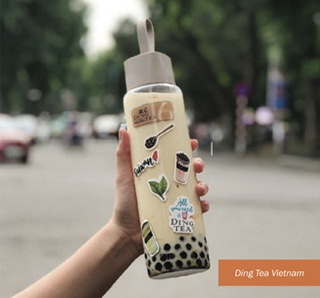 However, it seems milk tea craze in Vietnam is going on a downward trend. In a Vietnam Insider report published on November 26, 2019, it cited an analyst saying “the bubble tea shop market which was sizzling three years ago is on the decline.” About 20 bubble tea brands are competing for a slice of the market.
However, it seems milk tea craze in Vietnam is going on a downward trend. In a Vietnam Insider report published on November 26, 2019, it cited an analyst saying “the bubble tea shop market which was sizzling three years ago is on the decline.” About 20 bubble tea brands are competing for a slice of the market.
In the report, a bubble tea shop owner shared that after running some promotions, only some shops remain crowded. The slowing down is attributed to expensive raw materials and extremely high rents.
In September 2019, Taiwanese brand Ten Ren, which entered Vietnam in November 2017 and had 23 outlets, stopped operations. TP Tea Vietnam also closed down last year. Adding to the already fierce bubble tea shop market is the fact that many restaurants also now serve milk tea.
One thing is certain. Bubble tea fever continues to spread across Southeast Asia. The milk tea franchises and individual owners only need to step up and continue to introduce novel offerings. They need to constantly innovate with new variations and concoctions to keep the market hooked.







